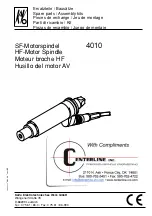
10. Put it together with the spring washer (D4) and cover (D2),and tighten locking nut (D3)
with the socket wrench (E6) clockwise . (See Fig. 34h, 34i)
NOTE:
The saw chain (D6) has not yet been tensioned. Tension the chain as
described under “
Saw chain tensioning
”. After operating the product for approx.
30min, adjust the chain
Guide Bar
Most guide bar problems can be prevented merely by keeping the product well maintained.
Incorrect filling and non-standard cutter and depth gauge settings are the causes of most
guide bar problems, primarily resulting in uneven bar wear. As the bar wears unevenly, the
rails widen, which may cause the chain to clatter and make it difficult to complete straight
cuts. If the guide bar is insufficiently lubricated and the product is operated with a saw chain
which is too tight, this will contribute to rapid bar wear. To help minimise bar wear,
maintenance of the guide bar as well as the saw chain is recommended.
1. Disassemble the guide bar and saw chain in reversed order from assembly.
2. Check the oiling port (D14) for clogging and clean if necessary to ensure proper
lubrication of the guide bar and saw chain during operation. Use a soft wire small enough
to insert into the oil discharge hole. (See Fig. 36a)
Fig. 35h
Fig. 35i
Fig. 36a
NOTE:
The condition of the oil passages can be easily checked. If the passages are clear,
the chain will automatically give off a spray of oil within seconds of the product
starting. Your product is equipped with an automatic oiling system.
3. Check the drive sprocket (D10). If it is worn or damaged due to strain, have it replaced by
an authorised service agent.
4. Clear residue from the rails on the guide bar (D7) using a screwdriver, putty knife, wire
brush or other similar tool. This will keep the oil passages open to provide proper
lubrication to the guide bar (D7) and saw chain (D6). (See Fig. 36b)
51
25CC PETROL MULTI TOOL TTK587GDO
Содержание TTK587GD0
Страница 1: ......
















































